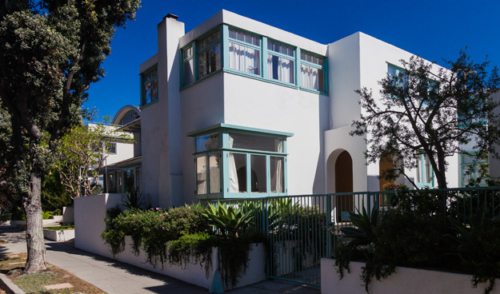Horatio West Court

- Known As
- Modernist
- Architect
- Irving Gill
- Built
- 1919
- Designated
- January 2, 1979
Horatio West Court is a masterpiece by one of the early-twentieth century’s most innovative architects, Irving Gill. This path-breaking structure, as well as others designed by Gill in Southern California, were among the first truly modernist buildings ever constructed, and were precursors to the International style that developed in subsequent decades.
Irving Gill was born in New York. As a young architect he moved to Chicago to work with the prominent firm of Adler & Sullivan. During these formative years Gill was exposed to the most up-to-date styles and building techniques and was supervised for a time by Frank Lloyd Wright. Due to health problems, Gill relocated to San Diego in 1893 and started his own firm. While historically-based styles, including the ubiquitous “Spanish” style, were gaining popularity in Southern California at the time, Gill pursued his own singular architectural vision. Horatio West Court, considered a stunning success by architectural historians, was built during his most productive decade—from 1910 to 1920—when Gill’s style had fully matured.
Above all Gill was committed to “clarity of form and simplicity of means.” As Gill himself put it, “We must dare to be simple, must have the courage to fling aside every device that distracts the eye from structural beauty.” While these ideas would eventually become mainstream, Gill’s insistence on the “bare honesty” of “the simple cube house with creamy walls, sheer and plain, rising boldly into the sky” was radical for his time.
Horatio West Court is an excellent example of Gill’s work. It showcases both trademark elements of his style as well as his lifelong interest in designing efficient and attractive homes for people of modest means. Horatio West Court consists of four small houses grouped around a concrete driveway that leads under a simple arch to additional apartments in the rear. Here, as in many of his mature works, Gill employed concrete construction, flat roofs, unadorned walls, ribbons of casement windows, and simple arches organized into a set of profoundly pleasing, if austere, geometrical forms. Horatio West Court affirms Gill’s maxim that “the straight line, the arch, the cube and the circle” are the source of architectural strength and beauty. Reflecting Gill’s concern for efficiency, the homes were designed, both inside and out, to reduce unnecessary labor and maintenance. Gill’s achievement at Horatio West Court attracted international interest, helped by an admiring Richard Neutra, who introduced Gill’s work to avant-garde architects in Europe.
Unfortunately, Gill suffered a series of professional setbacks in the years after Horatio West Court was constructed and he died in relative obscurity in 1936. For several decades after his death Gill’s pioneering work was overlooked and many of his buildings were demolished. Horatio West Court itself was in a state of serious disrepair by the 1960s. Luckily, a group of Gill enthusiasts rescued Horatio West Court in the 1970s and restored it to its present pristine condition. Irving Gill’s reputation has also been restored in recent decades and he is now recognized as a seminal figure in twentieth century modernist architecture. Horatio West Court was placed on the National Register of Historic Places in 1977.
Sources:
- David Gebhard and Robert Winter. Los Angeles: An Architectural Guide. Salt Lake City: Gibbs-Smith Publisher, 1994.
- Thomas S. Hines. Irving Gill and the Architecture of Reform. New York: Monacelli Press, 2000.
- Sam Hall Kaplan. LA Lost & Found: An Architectural History of Los Angeles. New York: Crown Publishers, 1987.
- William A. McClung. Landscapes of Desire: Anglo Mythologies of Los Angeles. Berkeley: University of California Press, 2000.
- Esther McCoy. Five California Architects. New York: Reinhold Publishing, 1960.
- Charles Moore. Los Angeles: The City Observed. Santa Monica: Hennessey & Ingalls, 1998.
- Carole Rifkind. A Field Guide to American Architecture. New York: Plume Books, 1980.